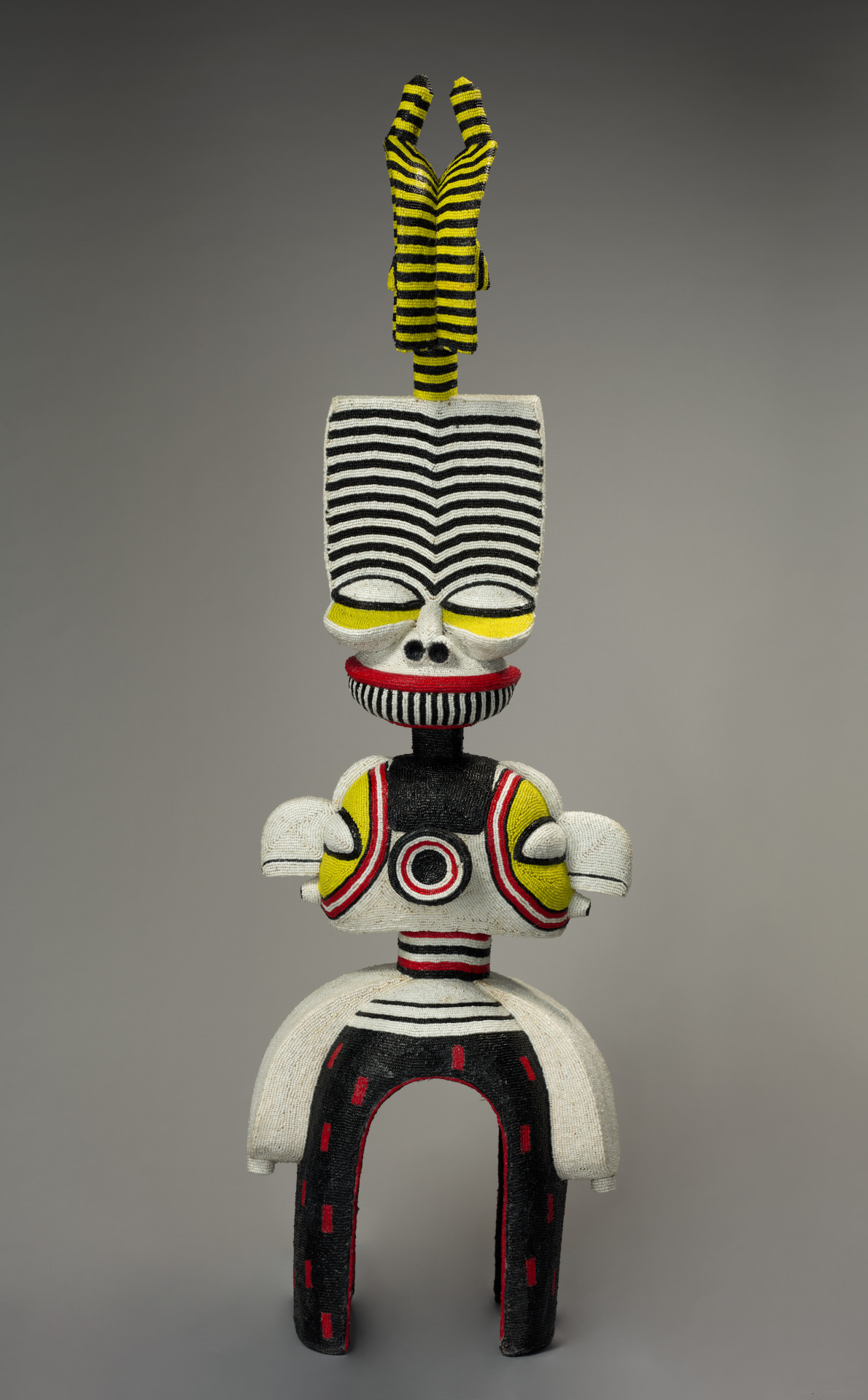
- Magazine Article
- Collection
Contemporary African Art
Two new works add a twist to canonical forms

Contemporary art speaks with an active voice. Its “present tense-ness” appeals to museum audiences, capturing and reflecting our immediate world. At the same time, contemporary art can revitalize or cast critical light on historical art. Works by contemporary African artists are no exception: they reflect how African people living both on and outside the continent engage with the world and think about the relationship between the present and the past. In other words, African art is not only about its historical canon.
Two recent acquisitions, conspicuously displayed in the center of the African gallery, orchestrate a dialogue between the old and the new. Totem 01/01–18 (Baga-Batcham-Alunga-Kota) is the first completed piece in the new Totems series by Douala-based Cameroonian artist Hervé Youmbi. Standing more than six feet high, the sculpture consists of masks and forms carved in canonical styles. Two abutting Kota-Mahongwe reliquary figures from Gabon sit atop an impressive tsesah crest, often called a Batcham mask in reference to the area of the Cameroon Grassfields where the earliest example was collected. The back of the crest bears a section of the four-sided initiation mask of the Bembe people’s Alunga society of eastern Democratic Republic of Congo. A Janus-faced Baga headdress of the countries of Guinea and Guinea-Bissau sits solidly at the base of the superstructure. Carved from a single block of wood, the sculpture is covered with a delicate mix of white, yellow, black, and red beads that elicits harmony and contrasts. Alternating bands of yellow and black beads gesture to the copper and brass strips that would have respectively covered the face of the original Kota-Mahongwe figures and the upper grooves in the crest.
As a composition, Totem 01/01–18 narrates the cycle of life—birth, growth, and the journey into the ancestral realm. Originally the Kota guardian figures, such as the Obamba example also on display in the African gallery, were attached to baskets that bore ancestral relics, symbolizing passage to the next world. Among the Bembe, a male secret society used the Alunga mask in the context of initiation and rites of passage to mark the transition from adolescence to adulthood. The mask is painted in contrasting colors of white and black, its owl-like visage alluding to the omniscient world of spirits and ancestors. With its incredible volume, scale, and imposing features, the regal Bamileke tsesah crest embodies high status, authority, and royal power. It was danced to mark important events in Western Cameroon such as the coronation of a new king or the funeral of a person of rank. Borne on the shoulder in traditional settings and danced to herald the farming season, the Baga mask represents a nurturing woman, fertility, and growth.

Twilight of the Idols (Fetish) 3 by South African–born conceptual artist Kendell Geers is the largest of the ten works in his acclaimed Twilight of the Idols series (2002–8). Geers has had a long-standing fascination with historical African art, and he developed an interest in Christian icons in the early 1990s while living in Johannesburg. This was the beginning of an enduring attempt to reconcile his European-Calvinist heritage with his African roots. But it was in Brussels, where Geers has lived since 2000, that he developed a more robust vocabulary and sophisticated approach in his examination of canonical African art.
For Twilight of the Idols (Fetish) 3, Geers appropriated a Kongo nkisi nkondi power figure that he found at a Brussels flea market. Typically, nkisi figures were used as protective totems to ward off malevolent spirits, to prevent or cure illness, and to hunt down persons with intention to cause harm. The nails mark the number of times that the object was ritually activated when still in use. Geers refers to such decommissioned or inactive figures as “lost” objects because, disconnected from their original context, they have lost their efficacy. He wrapped this figure with red-and-white chevron tape—the South African equivalent of the yellow-and-black caution tape used in the United States to demarcate a crime scene. Such tape simultaneously signals danger and acts as a shield from it. Geers’s use of the term “fetish” in the title deliberately evokes colonial prejudices—notably primitivism—associated with African art. In his reference to Kongolese art, avidly acquired today by museums and collectors throughout the world, Geers inverts the conventional understanding of the “fetish” by highlighting the desirability of African art to Western collectors who fetishize it.
As the imposing Totem 01/01–18 and Twilight of the Idols (Fetish) 3 demonstrate, contemporary African artists continue to draw from historical African art forms as idioms of expression, refashioning them to reflect present reality. Both works help to broaden the scope and understanding of African art and provide a compelling story about the continued relevance of long-standing artistic traditions. Their radiating presence reenergizes the surrounding historical objects, breathing new life into the African gallery.
Cleveland Art, September/October 2018